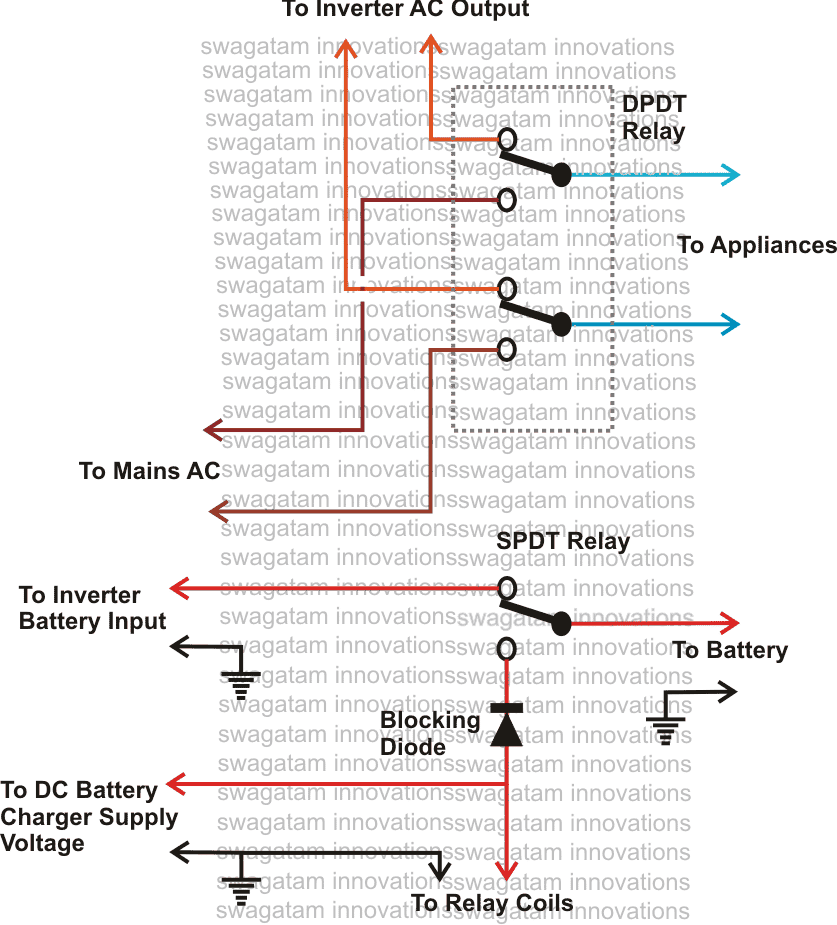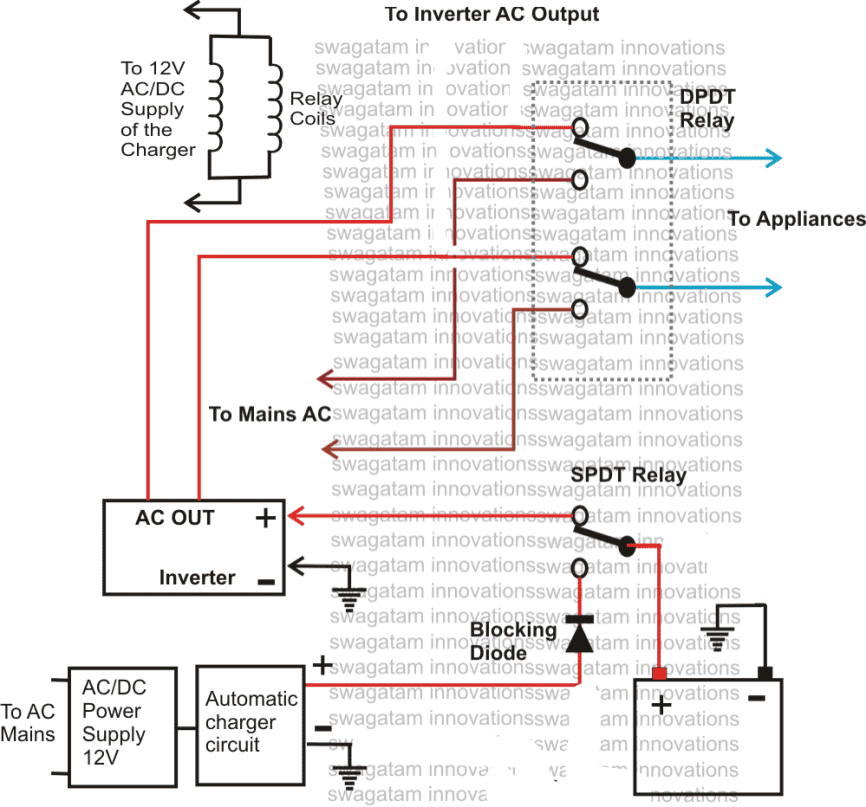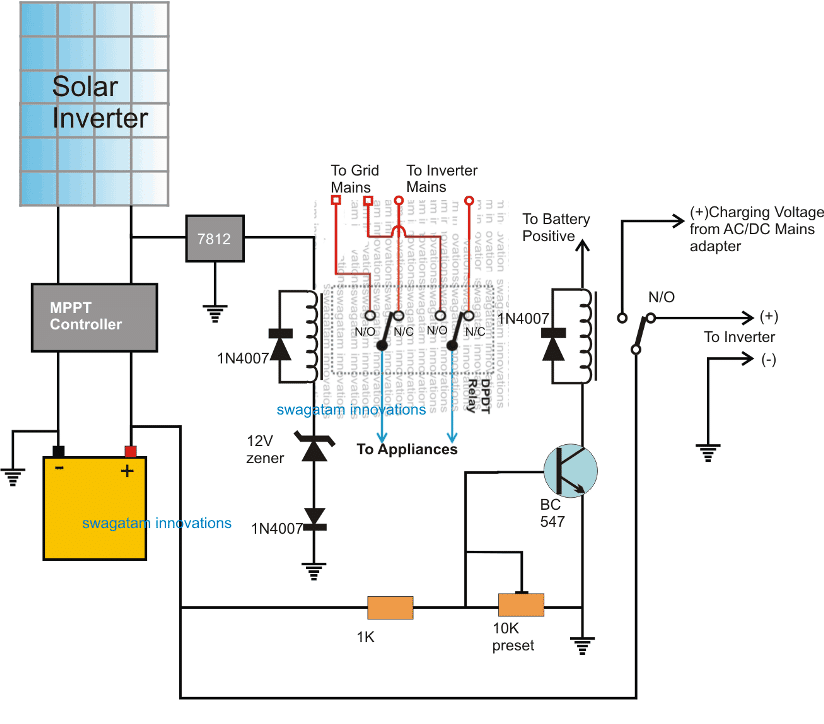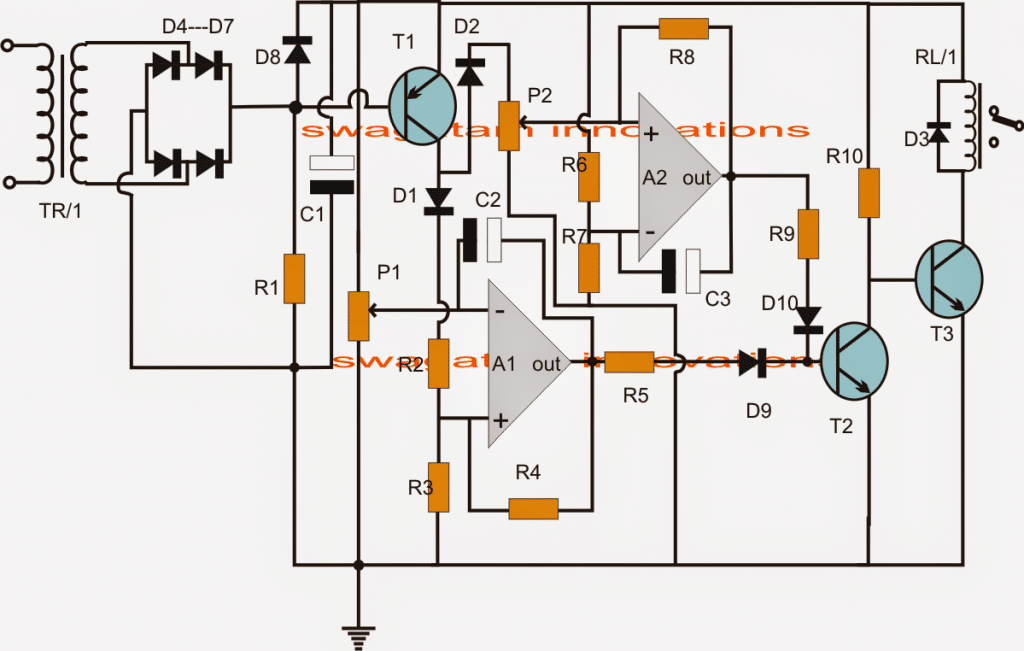I have been put forth with this question many times in this blog, how do we add a changeover selector switch for automatically toggling of an inverter when AC mains is present and vice versa.

And also the system must enable automatic switching of the battery charger such that when AC mains is present the inverter battery gets charged and when AC mains fails, the battery gets connected with the inverter for supplying AC to the load.
Circuit Objective
The configuration should be such that everything takes place automatically and the appliances are never switched OFF, just reverted from inverter AC to Mains AC and vice versa during mains power failures and restorations.
So here I am with a couple of simple yet very efficient little relay assembly module which will do all the above functions without letting you know about the implementations, everything is done automatically, silently and with great fluency.
1) Inverter Battery Changeover
Looking at the diagram we can see that the unit requires two relays, however one of them is a DPDT relay while the other one is an ordinary SPDT relay.
The shown position of the relays are in the N/C directions, meaning the relays are not powered, which will obviously be in the absence of the mains AC input.
At this position if we look at the DPDT relay, we find it to be connecting the inverter AC output to the appliances through its N/C contacts.
The lower SPDT relay is also in a deactivated position and is shown to be connecting the battery with the inverter so that the inverter remains operative.
Now let's assume that AC mains is restored, this will instantly power the battery charger which now becomes operative and supplies power to the relay coil.
The relays instantly become active and switch from N/C to N/O, which initiates the following actions:
The battery charger gets connected with the battery and the battery starts charging.
The battery gets cut OFF from the inverter and therefore the inverter becomes inactive and stops functioning.
The connected appliances are instantly diverted from the inverter AC to the mains AC within a split second such that the appliances doesn't even blink, giving an impression that nothing had happened and the are kept operative continuously without any interruptions.

A comprehensive version of the above can be witnessed below:

2) 10KVA Solar-Grid Inverter Changeover Circuit with Low Battery Protection
In the second concept below I have explained how to build a 10kva solar grid inverter changeover circuit which also includes a low battery protection feature. The idea was requested by Mr. Chandan Parashar.
Circuit Objectives and Requirements
- I have a solar panel system with 24 Panels of 24V and 250W connected to generate a output of 192V, 6000W and 24A. It is connected to 10KVA, 180V inverter which delivers the output to drive my appliances during daytime. During night the appliances and inverter run on grid supply.
- I request you to kindly design a circuit which will change the inverter input from grid to solar power once panel start generating the power and should again revert the input from solar to grid once darkness falls and solar power generation falls.
- Kindly design another circuit which will sense the batter.
- I request you to kindly make a circuit which will sense that battery is getting discharged below certain threshold value say 180V (esp during rainy season) and should switch the input from solar to grid even though some amount of solar power is being generated.
Designing the Circuit
The 10kva solar/grid automatic inverter changeover circuit with low battery protection which is requested above can be built using the concept presented in the following figure:

In this design which may be slightly different to the requested one, we can see a battery being charged by a solar panel though an MPPT controller circuit.
The solar MPPT controller charges the battery and also operates a connected inverter through an SPDT relay for facilitating the user with a free electricity supply during day time.
This SPDT relay shown at the extreme right side monitors the over-discharge condition or the low voltage situation of the battery and disconnects the inverter and the load from the battery whenever it reaches the lower threshold.
The low voltage situation could mostly take place during night when there's no solar supply available, and therefore N/C of the SPDT relay is linked with a AC/DC adapter supply source so that in an event of a low battery during night the battery could be charged for the time being through the mains supply.
A DPDT relay can be also witnessed attached with the solar panel, and this relay takes care of the mains supply changeover for the appliances. During day time when the solar supply is present, the DPDT activates and connects the appliances with the inverter supply, while at night it reverts the supply to grid supply in order to save the battery for a mains failure back up situation.
UPS Relay Changeover Circuit
The next concept makes an attempt to create a simple relay changeover circuit with zero crossing detector which may be used in inverter or UPS changeover applications.
This could be used for switching-over the output from AC mains to inverter mains during inappropriate voltage conditions. The idea was requested by Mr. Deepak.
Technical Specifications
I am looking for circuit comprising of the comparator (LM 324) to drive a relay. The objective of this circuit is to:
1. Sense AC supply and switch relay 'ON' when voltage is in between 180-250V.
2. Relay should turned 'ON' after 5 seconds
3. Relay should turned 'ON' after zero voltage detection of supplied AC (Zero voltage detector). This is to minimize arching in the relay contacts.
4. Finally and most importantly, the relay switchover time should be less than 5 ms as a normal off-line UPS does.
5. LED indicator to indicate the state of relay.
The above functionality can be found in UPS circuit which is bit complex to understanding since UPS has many other functional circuit beside this. So am looking for a separate simpler circuit which only works as mentioned above. Kindly help me to build the circuit.
Component available and other details:
AC mains = 220V
Battery = 12 V
Comparator = LM 324 or something similar
Transistor = BC 548 or BC 547
All type of Zener are available
All types of resistor are available
Thanks and Best regards,
Deepak
The Design
Referring to the simple UPS relay changeover circuit, the functioning of the various stages may be understood as follows:
T1 forms the sole zero detector component and triggers only when the AC mains half cycles are near to crossover points that's either below 0.6V or above -0.6V.
The AC half cycles are basically extracted from the bridge output and applied to the base of T1.
A1 and A2 are arranged as comparators for detecting the lower mains voltage threshold and the higher mains threshold respectively.
Under normal voltage conditions the outputs of A1 and A2 produce a low logic keeping T2 switched Off and T3 switched ON. This allows the relay to remain switched ON powering the connected appliances through mains voltage.
P1 is set such that voltage at the inverting input of A1 becomes just lower that the non-inverting input set by R2/R3, in case the mains voltage falls below the specified 180V.
When this happens, the output of A1 reverts from low to high triggering the relay driver stage and switching off the relay for the intended changeover from mains to inverter mode.
However this becomes possible only when the R2/R3 network receives the required positive potential from T1 which in turn takes place only during the zero crossings of the AC signals.
R4 makes sure that A1 does not stutter at the threshold point when the mains voltage goes below 180V or the set mark.
A2 is identically configured as A1, but it's positioned for detecting the higher cut-of limit of the mains voltage which is 250V.
Again the relay switch over implementation is executed only during the zero crossings of the mains AC with the help of T1.
Here R8 does the momentary latching job for ensuring a smooth transition of the switching.
C2 and C3 provides the required time lag before T2 can conduct fully and switch ON the relay. The values may be appropriately selected for achieving the desired delay lengths.
Circuit Diagram

Parts list for the zero crossing UPS relay changeover circuit
- R1 = 1k
- R2,R3,R4,R6,R7,R8 = 100K
- P1,P2 = 10K PRESET
- R5, R9 = 10K
- D3,D4---D10 = 1N4007
- C1,C2 = 1000uF/25V
- T1 = BC557
- T2 =BC547
- Z1= 3V ZENER
- A1/A2 = 1/2 IC LM324
- RL/1 = 12V, SPSDT RELAY
- TR/1 = 0-12V STEP DOWN TRASFORMER

Have Questions? Please Comment below to Solve your Queries! Comments must be Related to the above Topic!!